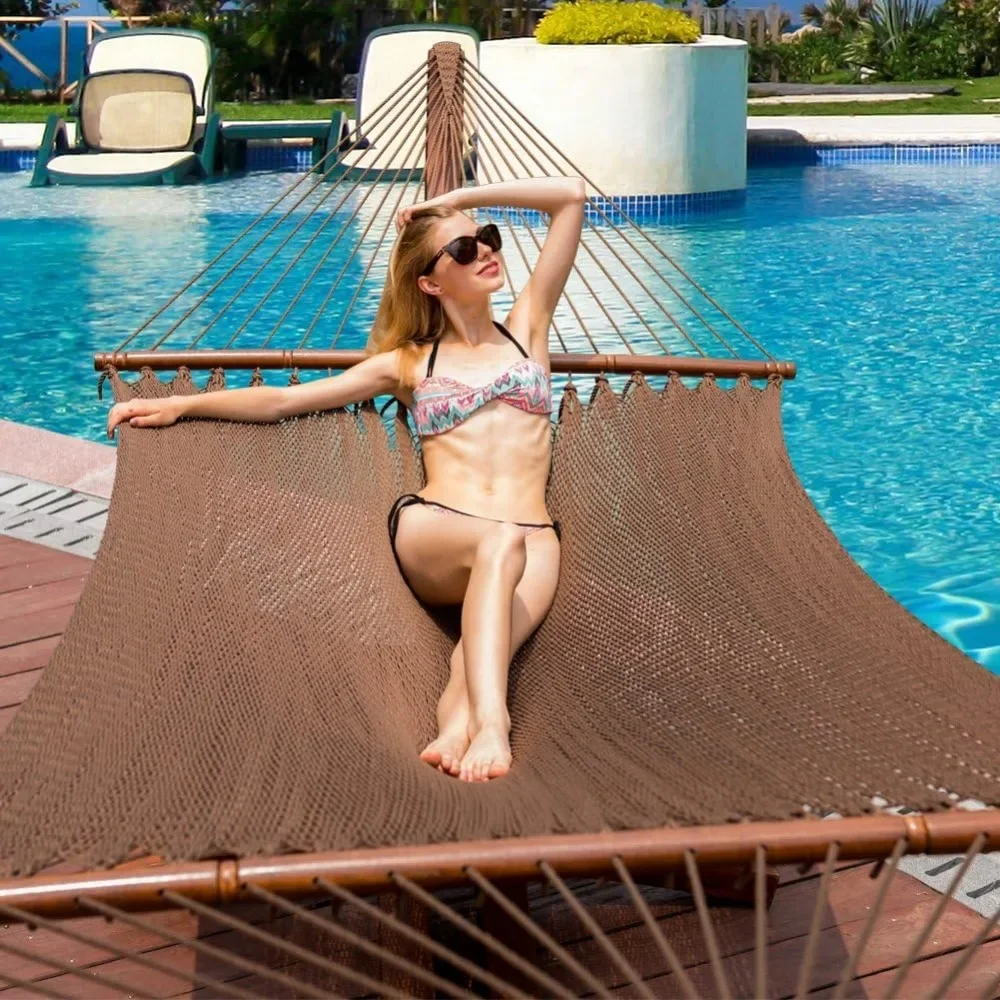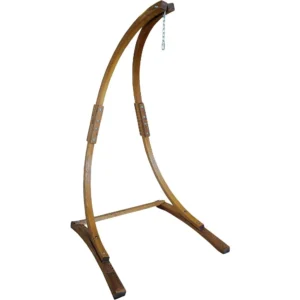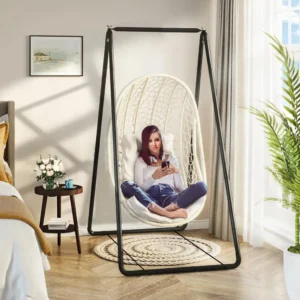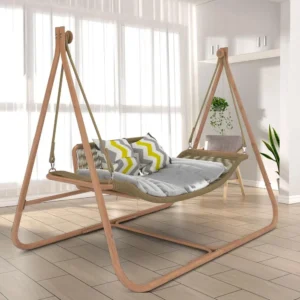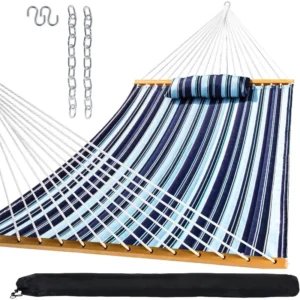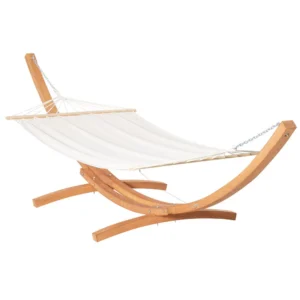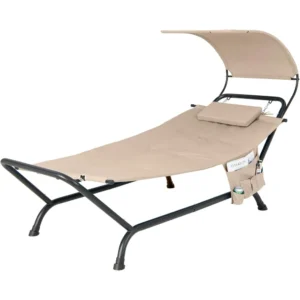1. The Enduring Allure of Classic Style Rope Hammocks
When you picture a hammock, chances are what comes to mind is the iconic classic rope hammock – that quintessential symbol of leisure featuring wooden spreader bars and an intricate woven rope pattern. These timeless pieces have graced American backyards, vacation homes, and resort getaways for generations, earning their place as the definitive relaxation statement.
Classic rope hammocks represent more than just a place to rest. They embody a tradition of craftsmanship and outdoor living that transcends trends. Their distinctive open weave design creates a gentle cradle for the body while allowing air to circulate freely – perfect for warm afternoons when comfort is paramount. The gentle swaying motion, supported by sturdy wooden spreader bars, delivers a sensory experience unlike any other outdoor furniture.
What makes these hammocks truly special is their dual nature as both functional relaxation tools and statement pieces for outdoor spaces. The natural materials and traditional construction methods create visual appeal that enhances gardens, patios, and poolside areas with an air of established elegance.
Despite the introduction of newer hammock styles with modern materials and designs, classic rope hammocks maintain their popularity because they deliver what we fundamentally seek from outdoor relaxation: comfort, beauty, and a connection to tradition. The visual weight of a well-crafted rope hammock, suspended between two points, creates an invitation to pause and unwind that few other pieces can match.
The allure of rope hammocks extends far beyond personal backyards. These classic designs appear in various rope hammock options at high-end resorts, boutique hotels, and elegant garden settings worldwide. Their presence signals a commitment to quality and a respect for the time-honored art of relaxation. When you see a classic rope hammock framed by mature trees or positioned on a sunny deck, you’re witnessing a design choice that communicates both sophistication and approachability.
For those seeking to create their own personal retreat, understanding how to integrate these classic pieces into your outdoor space is essential. Creating perfect hammock haven involves more than just hanging a hammock – it requires thoughtful consideration of setting, surroundings, and the sensory experience you wish to create.
2. Understanding the Anatomy of a Classic Rope Hammock
2.1 Spreader Bars: The Signature of Classic Design
The hallmark feature of any classic rope hammock is its wooden spreader bars – those sturdy horizontal components at each end that keep the hammock open and flat. These bars serve both functional and aesthetic purposes, transforming what would otherwise be a gathered bundle of rope into the iconic flat surface we associate with traditional American hammocks.
Quality spreader bars do more than just hold the hammock open; they distribute weight evenly across the entire surface, preventing uncomfortable bunching and ensuring a stable, comfortable resting place. The finest classic hammocks feature spreader bars crafted from select hardwoods known for their strength and weather resistance:
- Oak: Prized for its exceptional strength and classic grain pattern
- Maple: Offers excellent durability with a smooth, refined appearance
- Juniper: Naturally resistant to rot and insects
- Cumaru: Extremely dense hardwood with outstanding weather resistance
The standard dimensions for quality spreader bars typically range between 48-55 inches (122-140 cm) in width, providing ample support while maintaining proper proportions. The finishing process is equally important – premium spreader bars receive multiple coats of marine-grade varnish or sealant that enhances their natural beauty while protecting against moisture, UV damage, and temperature fluctuations.
The connection points between rope and wood represent another critical area where quality is immediately apparent. Superior spreader bar hammock designs feature reinforced drill holes with smooth edges that prevent rope fraying and ensure years of reliable service.
2.2 The Rope: Weaving Comfort and Durability
The rope itself forms the soul of a classic hammock, with its intricate weaving pattern determining both comfort and longevity. Traditional rope hammocks feature a distinctive diamond pattern that distributes weight efficiently while creating visual interest.
Rope thickness plays a crucial role in overall strength and comfort. Premium hammocks typically use rope measuring 6-8mm in diameter – thick enough to provide substantial support but not so bulky as to create pressure points against the body. The ply count (referring to the number of strands twisted together) directly impacts durability, with triple-ply construction representing the gold standard for hammocks intended for years of outdoor use.
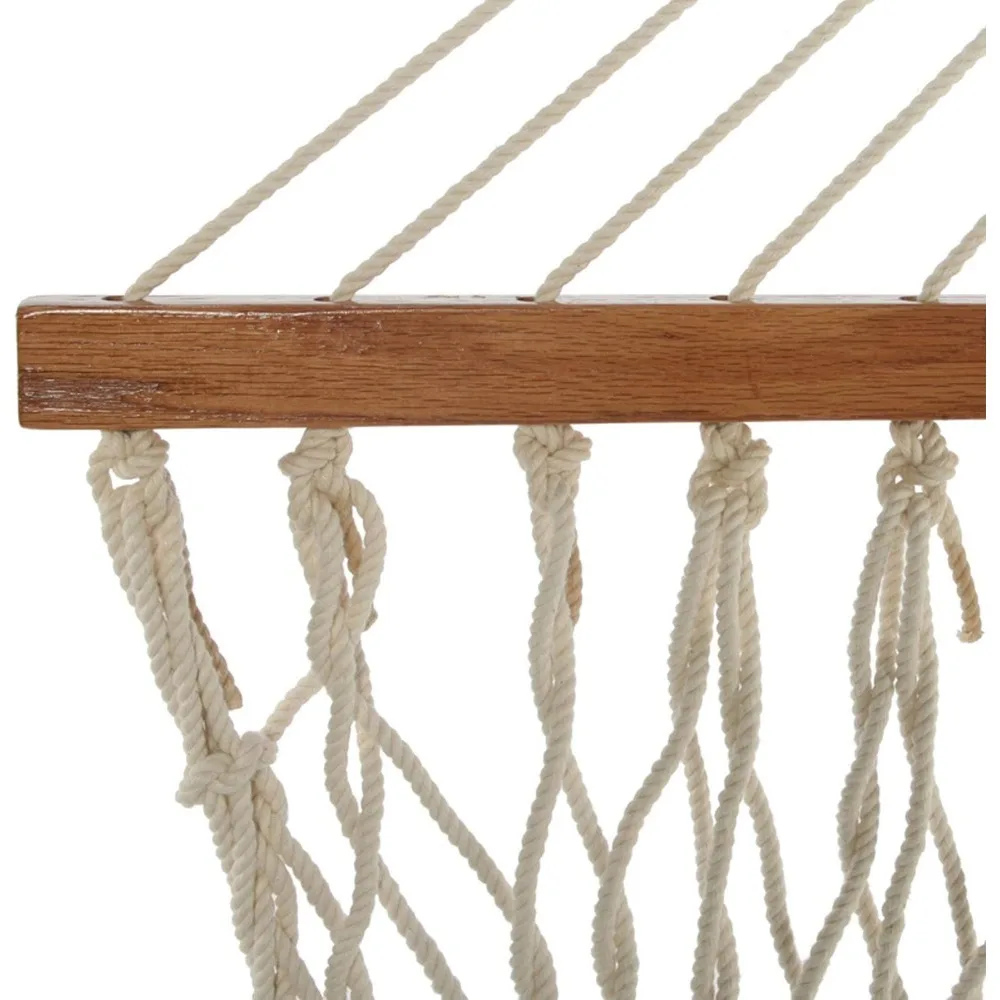
The artistry of a quality rope hammock becomes evident in its knotting techniques. Master craftspeople employ specialized knots that secure the rope while maintaining structural integrity under repeated use and varying weather conditions. These knots appear at critical junction points throughout the hammock, most visibly where the rope meets the spreader bars and at the gathering points that connect to suspension hardware.
Rope density – the number of rope strands per square inch – significantly impacts both comfort and durability. Tighter weaves generally provide more support and distribute weight more evenly, while slightly looser weaves offer more flexibility and body contouring. The finest hammocks strike an ideal balance between these qualities, creating a surface that feels secure yet adapts to your body’s contours.
2.3 Bed Construction: The Foundation of Comfort
The bed of a classic rope hammock represents the culmination of material selection and weaving technique. This central portion determines how the hammock performs during actual use, with subtle variations in construction creating noticeably different experiences.
The spacing between rope strands plays a crucial role in comfort. Premium hammocks typically maintain consistent spacing of approximately 1-2 inches (2.5-5 cm) throughout the bed. This spacing creates a surface that’s supportive without being rigid, allowing for natural body contouring while preventing excessive sinking or the uncomfortable “hammock wedgie” that poorly constructed options can create.
The attachment method between the rope bed and spreader bars represents another critical quality indicator. Superior hammocks feature rope that wraps around the spreader bar multiple times before being secured, distributing tension evenly and preventing stress concentration that can lead to premature failure.
Understanding how construction affects performance helps when evaluating hammock weight capacity guidelines. While a hammock might list a specific weight rating, the actual comfort experience depends on how effectively the rope bed distributes that weight across its entire surface. Well-constructed hammocks maintain their shape and support even when approaching their maximum capacity, while inferior options may stretch uncomfortably or feel unstable.
3. Material Matters: Choosing the Right Rope for Your Classic Hammock
3.1 Cotton Rope Hammocks: Natural Comfort and Tradition
Cotton remains the traditional choice for classic rope hammocks, beloved for its exceptional softness and natural feel against the skin. Pure cotton rope creates a hammock experience that’s difficult to replicate with synthetic materials, offering a distinctive combination of breathability and body-conforming comfort.
The primary advantage of cotton lies in its ability to naturally mold to body contours. Unlike more rigid materials, cotton fibers flex and adapt with use, creating an increasingly personalized comfort experience over time. This “breaking in” process results in a hammock that feels custom-fitted to your preferred relaxation position.
Cotton rope hammocks offer these distinct advantages:
* Exceptional softness from the first use
* Natural breathability that prevents overheating
* Authentic traditional appearance
* Pleasant texture against bare skin
* Environmentally friendly natural material
However, cotton’s natural properties also create some limitations:
* Requires protection from prolonged moisture exposure
* May develop mildew if not allowed to dry thoroughly
* Typically has shorter outdoor lifespan than synthetics
* Requires more frequent cleaning and maintenance
* May fade with extended sun exposure
For those wondering about outdoor durability, understanding whether it’s okay to leave a hammock outside is particularly important with cotton options. These hammocks perform best in covered locations with moderate humidity and should ideally be brought inside during rainy periods or stored during extended absences.
3.2 Polyester Rope Hammocks: Modern Durability with Classic Look
For those seeking the classic rope hammock appearance with enhanced weather resistance, polyester rope offers an excellent alternative. Modern polyester rope hammocks maintain the traditional aesthetic while adding significant performance benefits for outdoor environments.
High-quality polyester rope resists the elements that quickly degrade natural fibers. These hammocks stand up remarkably well to UV exposure, maintaining their structural integrity and color vibrancy even after multiple seasons in direct sunlight. Their moisture resistance provides protection against mold and mildew, while quick-drying properties mean less maintenance concern after rain showers.
Advantages of polyester rope hammocks include:
* Exceptional weather and UV resistance
* Minimal color fading over time
* Quick-drying after rain or morning dew
* Resistant to mold and mildew growth
* Significantly longer outdoor lifespan
* Lower maintenance requirements
Potential drawbacks to consider:
* Initially firmer feel compared to cotton
* Less natural sensation against skin
* May feel warmer during hot weather
* Typically higher initial cost

The initial firmness of polyester gradually softens with use, creating a more comfortable experience over time. Quality polyester options maintain the classic appearance of traditional hammocks while offering practical benefits that make them ideal for less-protected outdoor settings or regions with frequent rainfall.
3.3 Premium Rope Blends: The Best of Both Worlds
The most innovative segment of the market features proprietary rope blends that combine the best qualities of both natural and synthetic materials. These specialized materials represent the pinnacle of hammock technology, designed to deliver exceptional comfort alongside outstanding durability.
Premium rope blends typically begin with a core of synthetic material for strength and durability, wrapped in softer natural or synthetic fibers that provide comfort against the skin. This hybrid approach creates a hammock that feels remarkably similar to cotton while offering substantially improved weather resistance and longevity.
Advanced manufacturing techniques like solution-dying (where color is incorporated during fiber creation rather than applied to the surface) result in exceptional color retention. These hammocks maintain their vibrant appearance for many seasons without the fading common to surface-dyed options.
The premium materials and specialized manufacturing processes do command higher prices, but the value proposition becomes apparent when considering lifetime cost. A quality blended-material hammock may last two to three times longer than a basic cotton option, making it a more economical long-term choice for serious hammock enthusiasts.
For those seeking both classic style and modern performance, premium hammock sets with classic wooden stands showcase how traditional aesthetics can harmonize with advanced materials to create truly exceptional relaxation experiences.
4. Key Features That Define Quality and Classic Elegance
4.1 Hardware Components: Strength Meets Style
Often overlooked but crucial to both safety and aesthetics, the hardware components of a classic rope hammock deserve careful consideration. These metal elements not only connect your hammock to its suspension points but also contribute to its overall appearance and longevity.
Quality hardware components include:
O-rings and S-hooks: Premium hammocks feature thick, zinc-plated or stainless steel O-rings and S-hooks that resist bending and maintain structural integrity under repeated use. These should feel substantial when handled, with smooth edges and consistent plating.
Chains: Suspension chains should feature welded links of adequate thickness (typically 1/4 inch or 6mm) with consistent zinc plating or powder coating to prevent rust formation. Higher-quality hammocks include chains with smaller links that allow for more precise height adjustment.
End rings: The large rings at each end of the hammock bed should be properly sized for the rope thickness and feature welded construction rather than open seams that can separate under pressure.
Mounting hardware: Complete sets should include properly rated mounting hardware appropriate for the hammock’s weight capacity, ideally with rubber or plastic caps to prevent damage to mounting surfaces.
For those installing hammocks in various settings, understanding proper hammock installation requirements and safety guidelines helps ensure both optimal performance and risk-free enjoyment. Quality hardware not only enhances safety but also elevates the overall aesthetic with thoughtful details that complement the hammock’s design.
4.2 Craftsmanship Indicators: Signs of Quality Construction
Discerning quality in rope hammocks requires attention to specific construction details that separate premium products from basic alternatives. These subtle differences significantly impact both comfort and longevity.
One primary indicator of quality craftsmanship is consistency in weaving. Premium hammocks display uniform patterns throughout, with evenly spaced rope strands and consistent tension that creates a balanced support surface. This consistency should extend to the attachment points, where skilled knotting techniques prevent stress concentration.
Reinforcement at high-stress areas provides another telling quality signal. Superior hammocks feature additional wrapping or specialized knot techniques at spreader bar connections, end rings, and other tension points. These reinforcements distribute forces more effectively and prevent premature failure.
Finishing details further distinguish exceptional hammocks. Look for clean rope ends secured with heat-sealed tips or specialized knots rather than rough cuts. The edges of wooden components should be smoothly sanded and evenly finished, with no rough spots or inconsistent staining. These small details reflect the overall attention to quality throughout the manufacturing process.
4.3 Size and Weight Capacity: Finding Your Perfect Fit
Selecting the appropriate size ensures both comfort and proper function for your classic rope hammock. Standard sizing typically falls into two main categories:
| Hammock Type | Typical Dimensions (LxW) | Recommended For | Weight Capacity |
|---|---|---|---|
| Single/Individual | 11-13 ft × 4-5 ft (335-396 cm × 122-152 cm) | Solo relaxation | 250-350 lbs (113-159 kg) |
| Double/Two-Person | 13-15 ft × 5-6 ft (396-457 cm × 152-183 cm) | Couples or spacious solo use | 400-600 lbs (181-272 kg) |
Weight capacity represents a critical safety consideration when selecting a hammock. Quality manufacturers provide specific weight ratings based on actual testing rather than estimates. For safety and comfort, choose a hammock with a capacity that exceeds your needs by at least 50-100 pounds (23-45 kg).
The relationship between size, comfort, and stability becomes particularly important when considering double hammocks. While larger hammocks offer more space, they also require more substantial mounting points and greater distance between anchors. For those seeking spacious options, exploring double/two-person hammock sets provides insight into properly sized options with appropriate hardware and support systems.
5. Bringing Classic Style to Your Outdoors: Placement and Aesthetics
5.1 Creating an Atmosphere of Elegance
A classic rope hammock serves as both functional furniture and a design statement that can transform ordinary outdoor spaces into inviting retreats. When thoughtfully integrated into your landscape, these iconic pieces contribute to a cohesive aesthetic that elevates the entire environment.
The visual weight and organic lines of a rope hammock naturally complement various outdoor design themes. In coastal settings, white cotton rope hammocks with natural wood spreader bars echo nautical elements and create a relaxed seaside atmosphere. Traditional garden spaces benefit from the hammock’s classic proportions and natural materials that harmonize with established landscape features. Even modern outdoor designs can incorporate rope hammocks as statement pieces that add warmth and texture to contemporary settings.
Strategic placement enhances both the hammock’s visual appeal and your enjoyment of surrounding views. Consider positioning that frames appealing landscape features or architectural elements, creating a picture-perfect relaxation spot. The gentle curve of a properly hung hammock creates an inviting visual line that draws the eye and suggests leisure in a way few other outdoor furnishings can match.
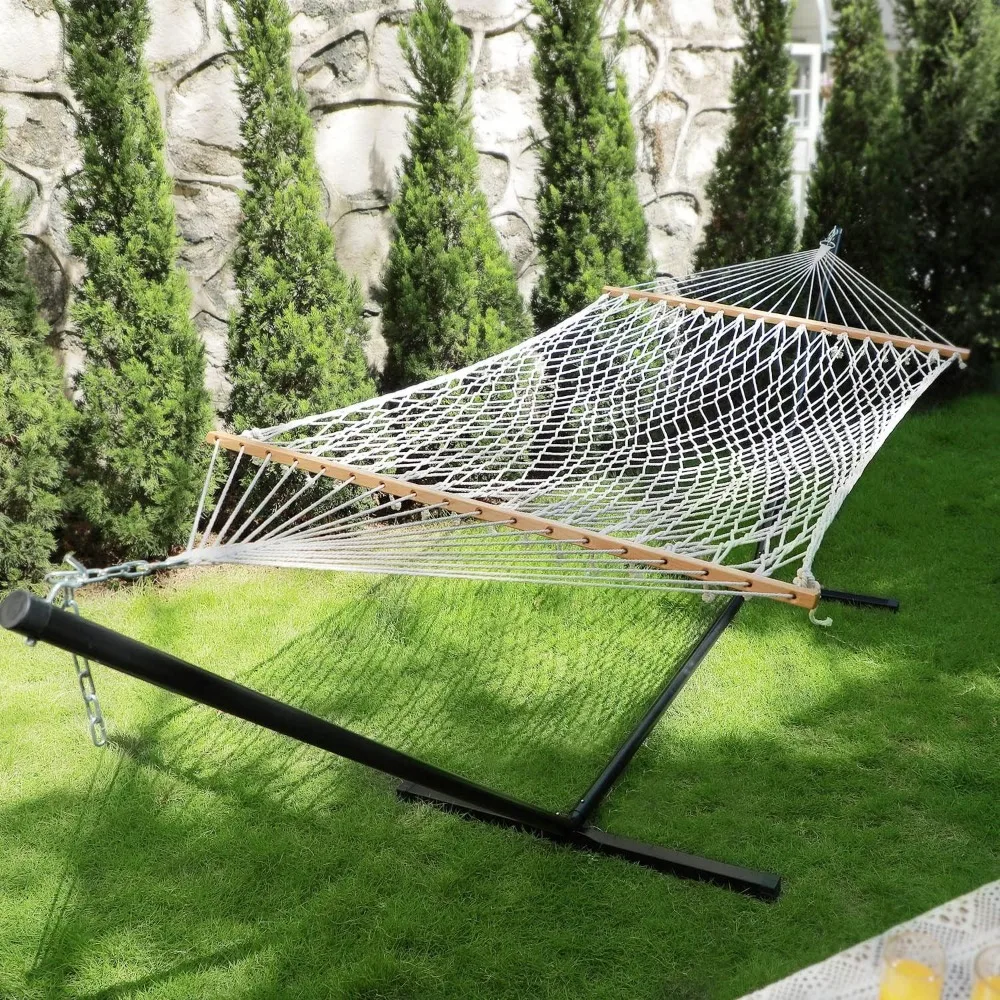
Color coordination with existing outdoor elements helps integrate your hammock into the overall design scheme. The natural tones of traditional wood and rope complement most outdoor palettes, while colored rope options can be selected to echo accent colors from nearby cushions, planters, or architectural details.
For comprehensive guidance on maximizing visual impact, exploring ideas for perfect hammock placement in home and garden helps create settings where your classic hammock becomes a centerpiece rather than an afterthought.
5.2 Ideal Placement Options for Classic Appeal
The placement of your rope hammock significantly affects both its visual impact and functional enjoyment. Consider these classic settings to showcase your hammock’s timeless appeal:
Between mature trees: The quintessential hammock setting requires trees at least 12 inches (30 cm) in diameter, spaced approximately 13-15 feet (4-4.6 meters) apart. This natural support system creates an organic integration with the landscape while providing dappled shade during daylight hours.
On a covered porch or veranda: This protected setting offers the perfect compromise between indoor comfort and outdoor atmosphere. The overhead covering provides protection from direct sun and light rain while maintaining views and fresh air circulation.
Beside a garden path: Positioning your hammock adjacent to a garden walkway creates a natural invitation to pause and enjoy the surroundings. This placement works particularly well when the hammock frames a view of flowering plants or water features.
Under a pergola or gazebo: These architectural elements provide ideal hammock support while creating a dedicated relaxation zone. The partial sun protection from overhead slats creates shifting patterns of light throughout the day.
Poolside retreat: A rope hammock positioned near (but at a safe distance from) a pool creates a perfect post-swim relaxation spot. The classic styling complements traditional pool designs while providing convenient lounging.
When selecting your ideal location, consider both aesthetic factors and practical concerns like sun orientation, prevailing winds, and privacy needs. For additional inspiration and practical advice, exploring the best indoor and outdoor hammock locations helps identify perfect spots for your specific setting and preferences.
5.3 Complementary Accessories: Completing the Classic Look
The right accessories enhance both the comfort and visual appeal of your classic rope hammock, creating a complete relaxation experience. These thoughtful additions maintain the traditional aesthetic while adding functionality:
Pillows and cushions designed specifically for hammocks provide neck and head support without detracting from the classic appearance. Look for weather-resistant options in complementary natural tones or subtle patterns that enhance rather than compete with the hammock’s woven texture.
Side tables positioned within arm’s reach offer convenience without disrupting the clean lines of your setup. Natural wood options with simple designs echo the craftsmanship of quality spreader bars while providing a stable surface for books, beverages, or personal items.
Ground coverings beneath your hammock create a defined relaxation zone while protecting the rope from ground moisture and soil contact. Natural fiber outdoor rugs or wood platforms in complementary tones unify the setting while adding practical benefits.
For locations with variable sun exposure, hammock sets with integrated canopy features provide shade protection that maintains the classic aesthetic. These thoughtfully designed additions extend usable hours while preserving the traditional hammock experience.
6. Installation and Setup for Your Rope Hammock
6.1 Between Trees: The Classic Natural Setup
Installing your rope hammock between trees creates the quintessential outdoor relaxation setting, but proper technique ensures both safety and optimal comfort. Start by selecting appropriate trees with a minimum diameter of 12 inches (30 cm) to provide adequate support for repeated use.
To protect both the trees and your hammock, always use proper tree straps rather than direct rope or chain contact with bark. Quality tree straps distribute pressure across a wider surface area, preventing damage to the tree’s cambium layer while providing more stable support for your hammock. These straps should wrap completely around the trunk and attach to your hammock’s suspension hardware.
For optimal hanging height and angle:
1. Position tree straps approximately 5-6 feet (1.5-1.8 meters) above ground level
2. Ensure proper distance between trees – typically 13-15 feet (4-4.6 meters) for standard hammocks
3. Adjust chain length to create appropriate sag in the hammock (approximately 30° angle from horizontal)
4. Test the setup with gentle weight before full relaxation
Safety considerations include checking the health of supporting trees (avoiding dead branches or signs of disease), inspecting hardware connections before each use, and maintaining adequate clearance from hazards like fire pits or thorny plants.
For comprehensive guidance on safe enjoyment, the indoor and outdoor hammock safety guide provides essential information for various installation scenarios and use cases.
6.2 Using a Hammock Stand: Versatility with Classic Appeal
Hammock stands offer the perfect solution for enjoying your classic rope hammock without suitable trees or permanent mounting options. These freestanding structures provide reliable support while adding design elements that complement the hammock’s traditional appearance.
When selecting a stand for your rope hammock, consider both material and design. Wooden stands offer traditional elegance that pairs beautifully with classic rope hammocks, creating a cohesive aesthetic. Premium wooden hammock stands feature weather-resistant hardwoods with protective finishes that withstand outdoor conditions. Steel options provide excellent stability with powder-coated finishes that resist corrosion while offering contemporary styling.
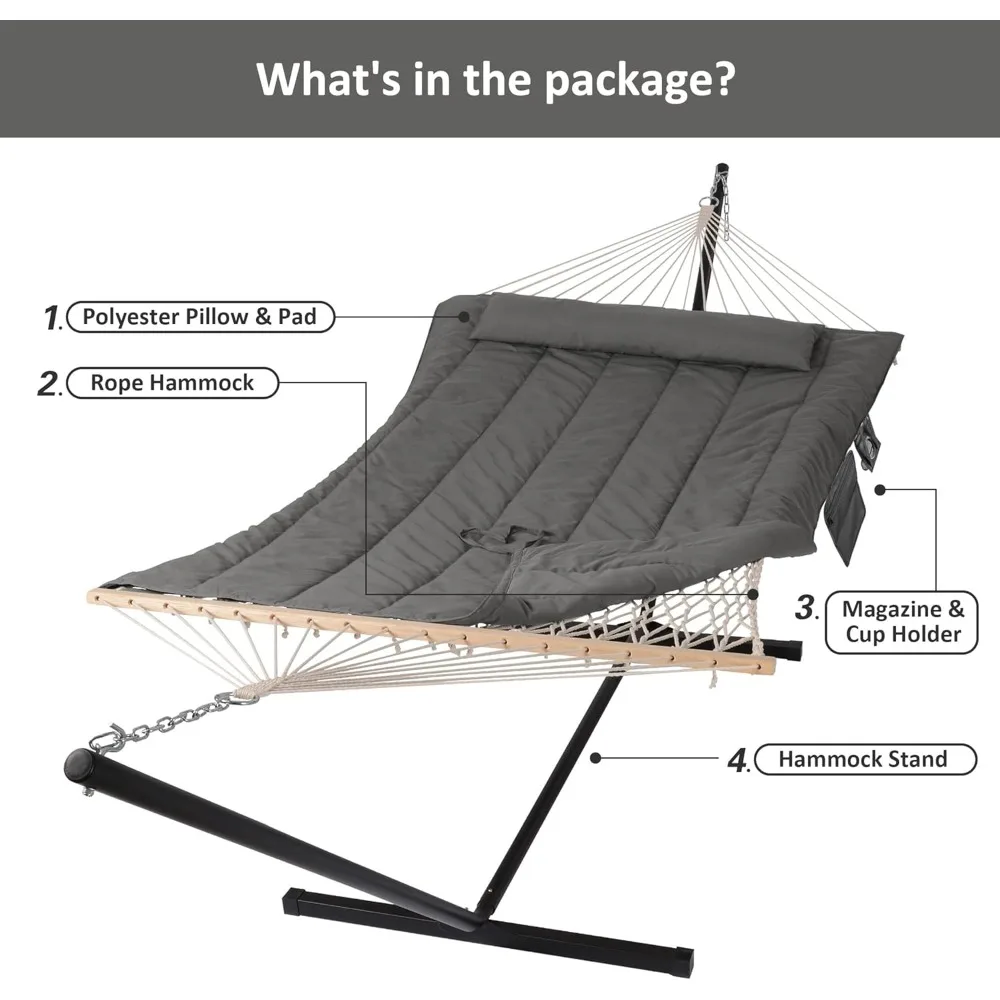
Assembly typically involves connecting major components with included hardware, following manufacturer instructions for proper alignment and tightening sequence. Most quality stands require no special tools, though having a socket wrench or adjustable wrench on hand can make the process easier.
Surface considerations affect both stability and longevity. Place stands on level ground, using patio stones or deck areas when possible to prevent sinking. For grass or soil placement, consider adding flat paving stones under the feet to distribute weight and prevent subsidence during use.
6.3 Achieving the Perfect Hang: Comfort and Safety
The difference between an adequate hammock experience and an exceptional one often comes down to achieving the perfect hanging geometry. This ideal setup combines proper height, appropriate tension, and optimal body positioning.
The 30° angle rule serves as a reliable guide for proper hammock suspension. When viewed from the side, the suspension ropes or chains should form approximately a 30° angle from horizontal when the hammock is unoccupied. This angle allows for appropriate sag when weighted, creating the ideal balance between support and comfort.
Optimal hanging height places the hammock’s lowest point approximately 18 inches (45 cm) above the ground when seated. This height allows for easy entry and exit while providing adequate clearance from ground moisture and debris. If your setup feels too high or low, adjust the chain links or suspension straps until you achieve this ideal height.
For maximum comfort, position yourself diagonally across the hammock rather than parallel to the spreader bars. This diagonal orientation creates a flatter lying surface and more even weight distribution, reducing pressure points and preventing excessive curvature of your body.
After installation, perform regular safety checks to ensure all components remain secure. Inspect rope condition, hardware connections, and support structures before each extended use, especially after extreme weather events that may have affected components.
Dark Wood Hammock Sets, Porch Swing Chair Sets
$653.82 Select options This product has multiple variants. The options may be chosen on the product pageA-Frame Stand Hammock Sets, Swinging Hammock Chair Sets
$154.62 Select options This product has multiple variants. The options may be chosen on the product pageLight Wood Hammock Sets, Swinging Hammock Chair Sets
$1,359.35 Select options This product has multiple variants. The options may be chosen on the product pageClassic Wooden Stand Hammock Sets, Heavy Duty Hammock Sets
$1,061.68 Select options This product has multiple variants. The options may be chosen on the product pageHammock Sets with Canopy, Heavy Duty Hammock Sets
$286.31 Select options This product has multiple variants. The options may be chosen on the product page
7. Care and Maintenance: Preserving Your Classic Hammock’s Beauty
7.1 Material-Specific Care Techniques
Different rope materials require specific care approaches to maintain their appearance and structural integrity. Following these material-appropriate techniques significantly extends your hammock’s usable life.
For cotton rope hammocks:
* Brush away loose dirt and debris regularly with a soft brush
* Wash with mild soap and cool water for deeper cleaning (avoid bleach or harsh detergents)
* Rinse thoroughly to remove all soap residue
* Allow to dry completely before storing or using, ideally hanging in a breezy location
* Consider applying a fabric protector designed for cotton to enhance weather resistance
Polyester and synthetic blend hammocks benefit from:
* Regular rinsing with a garden hose to remove surface dust and pollen
* Cleaning with mild detergent for stubborn stains or accumulated grime
* Brief soaking (15-30 minutes) in a solution of warm water and oxygen-based cleaner for deeper cleaning
* Thorough rinsing to remove all cleaning agents
* Quick drying in sunlight before use or storage
Seasonal care differences matter significantly. During active use seasons, quick rinses after rain or weekly cleaning prevent buildup that can lead to permanent staining. End-of-season deep cleaning before storage prevents degradation of materials during idle periods.
The differences between caring for indoor versus outdoor hammocks affect maintenance frequency and approach. Indoor hammocks generally require less frequent cleaning but still benefit from occasional freshening to remove dust and body oils.
7.2 Preserving Wooden Components and Hardware
Wooden spreader bars represent both a functional component and a key aesthetic element of classic rope hammocks. Proper maintenance ensures they remain beautiful and structurally sound for years of enjoyment.
To maintain wooden components:
* Inspect regularly for signs of wear, splitting, or finish deterioration
* Clean with a damp cloth and mild soap, avoiding soaking the wood
* Apply marine-grade varnish or sealant annually (or when water no longer beads on the surface)
* Keep wooden parts elevated from ground contact when not in use
* Consider light sanding followed by refinishing if surface damage occurs
Hardware maintenance is equally important:
* Inspect chains, hooks, and rings for signs of rust or bending
* Remove surface rust promptly with fine steel wool
* Apply a thin coat of marine-grade lubricant to moving parts
* Replace any components showing significant corrosion or deformation
* Tighten any loose connections before each use
For hammocks used in coastal environments, more frequent inspection and maintenance protects against accelerated corrosion from salt air. Freshwater rinsing after exposure to salt spray significantly extends hardware life in these challenging conditions.
7.3 Off-Season Storage for Longevity
Proper storage during periods of non-use dramatically extends your hammock’s usable life, particularly for cotton and natural fiber options. Taking the time to prepare and store your hammock correctly prevents unnecessary deterioration and ensures it’s ready for use when outdoor season returns.
Before storage:
* Clean thoroughly following material-appropriate methods
* Allow to dry completely (24-48 hours in a well-ventilated area)
* Inspect for any damage that should be repaired before next use
* Apply appropriate protectants to wooden components
Ideal storage conditions include:
* Cool, dry environment with minimal temperature fluctuations
* Protection from direct sunlight that can fade materials
* Elevation from concrete floors that may transfer moisture
* Adequate air circulation to prevent mildew formation
Storage containers should allow some airflow while protecting from dust and pests. Breathable fabric bags work well, as do ventilated plastic containers. Avoid completely sealed plastic bags that can trap moisture and promote mildew growth.
8. Finding Your Perfect Classic Style Rope Hammock: A Buyer’s Guide
8.1 Quality Indicators: What to Look For
Identifying quality in rope hammocks requires attention to specific details that signal superior craftsmanship and materials. These indicators help distinguish premium options from those that may disappoint after limited use.
When evaluating rope construction, look for:
* Consistent thickness throughout all rope sections
* Tight, uniform weaving patterns without gaps or irregularities
* Secure knots with clean finishing and no loose ends
* Smooth transitions between different sections of the hammock
* Reinforcement at high-stress connection points
Spreader bar quality becomes evident when you examine:
* Hardwood construction with straight grain patterns
* Smooth, even finish without rough spots or thin areas
* Clean, precision-drilled holes for rope passage
* Evidence of multiple varnish or sealant coats
* Substantial thickness appropriate for the hammock’s size
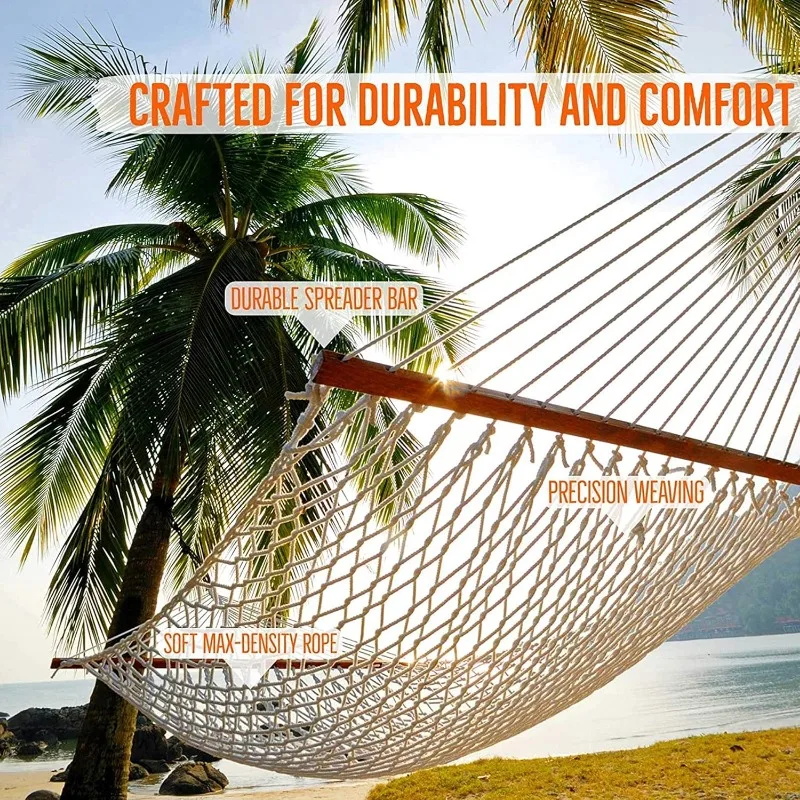
Hardware quality shows in:
* Substantial weight and thickness in all metal components
* Consistent plating or coating without thin spots
* Smooth welds without rough edges
* Properly closed chain links that resist opening under pressure
* Appropriately sized components for the hammock’s weight rating
Overall construction integrity manifests through symmetry, balanced proportions, and attention to finishing details. Quality hammocks maintain their shape when suspended empty and show consistent workmanship throughout, rather than just in visible areas.
For alternative support options that maintain quality standards, A-frame stand hammock sets provide excellent stability with aesthetic appeal that complements classic rope designs.
8.2 Value Considerations: Beyond the Price Tag
Understanding the relationship between price and long-term value helps make informed investment decisions when selecting a classic rope hammock. While initial cost differences between basic and premium options may seem substantial, considering the full ownership experience often justifies choosing higher-quality hammocks.
Quality rope hammocks typically demonstrate their value through:
* Extended usable lifespan (often 5-10+ years versus 1-3 years for budget options)
* Better resistance to environmental damage and wear
* Superior comfort that encourages frequent use
* Enhanced aesthetic appeal that elevates outdoor spaces
* Lower maintenance requirements and repair frequency
A useful approach for evaluating overall value involves calculating the “cost per season” rather than focusing solely on purchase price. By dividing the total cost by the expected lifespan in years, you can compare the annual investment across different quality levels. Premium options often prove more economical when viewed through this lens.
Warranty provisions serve as both protection and an indicator of manufacturer confidence. Look for guarantees that cover both materials and workmanship for multiple seasons, suggesting the product is built to last. Some premium manufacturers offer warranties specifically for structural components, providing peace of mind regarding the hammock’s core functionality.
For those seeking maximum durability regardless of conditions, exploring heavy-duty hammock sets provides options specifically engineered for exceptional longevity and performance under demanding use.
8.3 Evaluating User Experiences and Reviews
Customer feedback provides valuable insight when selecting a rope hammock, particularly regarding long-term performance and satisfaction. Learning to interpret reviews effectively helps identify options that will meet your specific needs and expectations.
When reviewing customer feedback, look for comments addressing:
* Comfort during extended use (not just initial impressions)
* Performance after exposure to weather conditions
* Durability of specific components (rope, spreader bars, hardware)
* Ease of maintenance and cleaning
* How the product ages over multiple seasons
Be particularly attentive to reviews mentioning similar usage patterns to your intended application. A hammock that performs beautifully in a covered porch setting might show different results when exposed to direct sun and rain in an open yard.
Red flags in reviews often include mentions of:
* Rope stretching significantly after limited use
* Wood splitting or cracking within the first season
* Hardware rusting or bending under normal weight
* Significant color fading after minimal sun exposure
* Difficulty obtaining replacement parts when needed
Questions to consider when reading feedback include whether the reviewer used the product as intended, whether they followed care instructions, and whether their expectations aligned with the product’s intended use case and price point.
9. The Timeless Investment: Why Classic Rope Hammocks Endure
Classic rope hammocks have maintained their appeal through generations not merely as functional objects but as expressions of a particular approach to leisure and outdoor living. Their enduring popularity stems from a combination of tangible and intangible qualities that together create an experience greater than the sum of their parts.
The sensory experience of a quality rope hammock creates memories that persist long after you’ve risen from your relaxation session. The slight give of woven rope against your back, the gentle creaking of hardwood spreader bars, the rhythmic swaying that synchronizes with your breathing – these tactile and auditory elements form a multisensory experience that modern alternatives struggle to replicate.
Beyond physical comfort, classic rope hammocks connect us to traditions of craftsmanship and leisure that transcend trends. There’s something deeply satisfying about enjoying the same style of outdoor furniture that has provided respite for generations, particularly when that enjoyment takes place in natural settings where time seems less urgent.
With proper selection and care, a quality rope hammock represents not merely a purchase but a lasting investment in your outdoor living experience. The timeless design of classic hammocks continues to complement diverse architectural styles and landscape designs, adapting gracefully as surrounding elements evolve over years of enjoyment.
Perhaps most importantly, rope hammocks create spaces for genuine disconnection in an increasingly connected world. Their very presence signals permission to pause, to set aside productivity in favor of contemplation or conversation. In this way, they serve not just as furniture but as an invitation to a particular way of being – unhurried, present, and connected to both natural surroundings and the timeless human need for rest.
10. FAQ: Common Questions About Classic Rope Hammocks
10.1 Are Rope Hammocks Comfortable for Extended Use?
Rope hammocks offer excellent comfort for extended relaxation, particularly when properly installed and used. Their open weave design provides natural ventilation that prevents overheating during warm weather, while the slight flexibility of the rope creates a supportive surface that adapts to your body’s contours.
Different body types experience rope hammocks differently, with weight distribution playing a key role in comfort. Heavier individuals may prefer tighter weaves and thicker rope for adequate support, while lighter persons might enjoy the greater conformity of slightly looser weaves. Diagonal positioning significantly enhances comfort by creating a flatter lying surface and more even weight distribution.
Most rope hammocks experience a breaking-in period where the rope stretches slightly and adapts to typical use patterns. Cotton hammocks particularly benefit from this process, becoming increasingly comfortable over the first few weeks of regular use. For enhanced comfort during extended sessions, consider adding a thin outdoor blanket or dedicated hammock pad that maintains airflow while providing additional cushioning.
Those considering various placement options might find valuable information about the best places to hang hammocks indoors, where comfort considerations differ somewhat from outdoor settings.
10.2 Can Rope Hammocks Be Left Outdoors Year-Round?
The ability to leave rope hammocks outdoors year-round depends primarily on the rope material and your local climate conditions. While all hammocks benefit from protection during severe weather, their general outdoor durability varies significantly.
Cotton rope hammocks require the most protection and generally should not be left exposed year-round in most climates. They absorb moisture readily and can develop mildew if not allowed to dry completely between exposures. In regions with frequent rainfall or high humidity, cotton hammocks should be stored during extended wet periods and brought inside for winter months.
Polyester and synthetic blend hammocks offer substantially greater weather resistance and can remain outdoors for extended periods in moderate climates. Their resistance to moisture, UV damage, and mildew makes them suitable for semi-permanent outdoor placement, though they still benefit from protective covers during extreme weather events.
For hammocks that must remain outdoors, protective measures significantly extend lifespan. Consider using water-resistant hammock covers during rainy periods, positioning under partial cover where possible, and removing during severe storms or winter weather in cold climates.
10.3 How Do I Choose Between a Single and Double Rope Hammock?
Selecting between single and double rope hammocks involves considering both your typical usage patterns and available space. While the terms suggest occupancy, the choice extends beyond simply whether one or two people will use the hammock.
Single hammocks (typically 4-5 feet or 122-152 cm wide) provide adequate space for individual use with a more enveloping feel that many users find comforting. Their narrower width creates a more pronounced center pocket that naturally cradles the body. These hammocks require less installation space and typically weigh less, making them more portable and suitable for areas with limited hanging options.
Double hammocks (5-6 feet or 152-183 cm wide) offer significantly more surface area, creating a flatter lying surface even for solo users. This additional width allows for diagonal positioning that many find more comfortable for extended relaxation. For couples, the extra space provides enough room for two average-sized adults to share the hammock, though with less individual movement freedom than when used solo.
When making your decision, consider both immediate needs and potential future uses. Many solo users ultimately prefer double hammocks for their versatility and spaciousness, particularly for extended relaxation sessions. For safety considerations in various settings, learning whether it’s safe to hang hammocks indoors provides important guidance that applies to both size options.
10.4 What’s the Best Way to Clean a Rope Hammock Without Damaging It?
Proper cleaning techniques preserve both the appearance and structural integrity of your rope hammock. The specific approach varies by material, but some general principles apply across all types.
For routine cleaning of cotton rope hammocks:
1. Spread the hammock flat on a clean surface
2. Brush away loose debris with a soft brush
3. Mix mild soap (like Woolite or castile soap) with cool water
4. Clean with a soft cloth or soft-bristled brush, focusing on stained areas
5. Rinse thoroughly with clean water until no soap remains
6. Hang to dry completely in a breezy location away from direct sunlight
For polyester or synthetic blend hammocks:
1. Rinse with a garden hose to remove surface dirt
2. For stubborn stains, use a diluted solution of mild detergent
3. Gently scrub affected areas with a soft brush
4. Rinse completely until water runs clear
5. Allow to dry fully in the sun before using or storing
For tough stains on either material, avoid bleach or harsh chemicals that can damage fibers. Instead, try an oxygen-based cleaner diluted according to package directions, applying only to affected areas and rinsing thoroughly afterward.
Regular maintenance significantly reduces the need for deep cleaning. Quick rinses after exposure to tree sap, bird droppings, or food spills prevent these substances from bonding permanently with the fibers. Allowing the hammock to dry completely after any cleaning or rain exposure prevents mildew growth that can weaken rope fibers over time.

